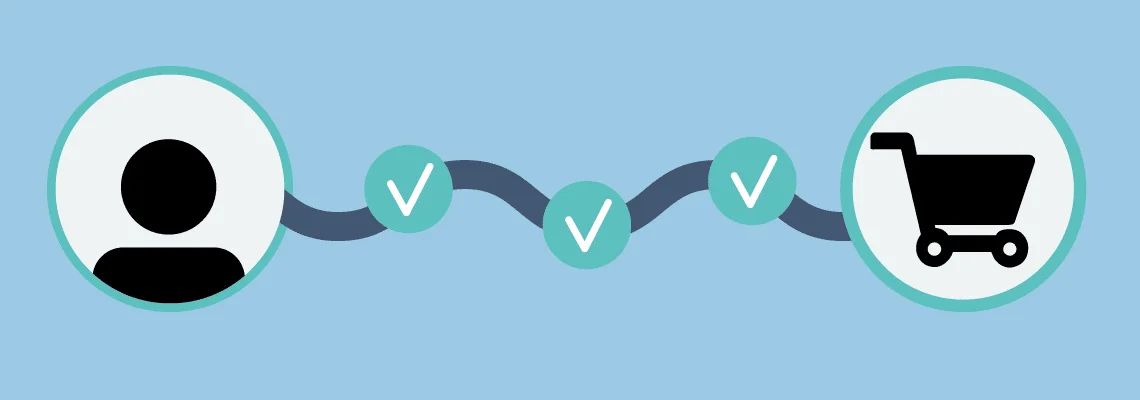

In our digital age, customers no longer follow a linear path from consideration to purchase. Research by Google has shown that the customer journey is much more complex.
A classic customer journey includes the following stages: Awareness, Consideration, Purchase, Loyalty and Promotion. There are many different touch points a consumer interacts with before making a decision to solve a problem through a purchase. Understanding how the customer ultimately chose your product is crucial to making the right decisions that will help you achieve more sales.
Google spent 6 months, as a function of a study, looking at clickstream data from thousands of online users. The customer journey now turns out to be much more complex than traditional theory.
Below are 3 different customer journeys that immediately show that consumers go through much more complicated processes before buying something:

Ella's customer journey for face cream
THE BEST BRANDS AND MORE
Some consumers are true researchers. This is reflected in their customer journey. Ella is a prime example of a purebred researcher. She does not follow a linear path in the customer journey. Once she learns more about a specific brand or product, she broadens her search again. So you get a customer journey shaped like an accordion instead of a funnel. She looks at a few brands before finally deciding to make her purchase in a store.
Ella's 4 mobile searches (130 touchpoints)
- What is a good hypoallergenic face cream?
- Are (Brand A) face creams hypoallergenic?
- What brands of face creams are hypoallergenic?
- Face cream (Brand B) hypoallergenic review?
Bart's customer journey for a new speaker
THE LAST BRAND STANDING
Sometimes a consumer will first try to solve a problem without making a purchase. For example, Bart first wants to solve noise on his cheater. When this turns out to be too complicated, Bart decides to replace his speaker anyway. Now the real customer journey begins. However, Bart compares multiple products on multiple sites. With each new search he looks at the top results regardless of whether they are ads or organic results. Thus, through Google search, YouTube reviews and online test scores, Bart will make a judgment about a chosen product before buying it.
Bart's 3 mobile searches (257 touchpoints)
- Noise on speaker
- Choosing new speakers on the market
- Best speaker with clearest sound
Pia's search for the perfect chocolates
SPECIFICALLY WITH ENOUGH SEARCHES
Consumers appear to be very savvy with search engines. Furthermore, they are increasingly using multiple touchpoints. Pia's search for ideal chocolates seems traditional, yet the customer journey here also has multiple touchpoints. Pia, meanwhile, has done plenty of research. For example, she researched different praline stores, stocks and types of chocolates before deciding to go to a store.
Pia has done 1 desktop search (20 touchpoints)
- Free chocolates gift
Decision
Conclusion of the study: the customer journey differs for each user and even takes different forms. People differ in their search behavior and this creates different types of customer journeys. At the same time, we see that nowadays many more different touchpoints are needed to reach a purchase.
3 golden tips for your online marketing funnel
So what insights do you draw from Google's research to optimize your online marketing funnel for a complex customer journey?
USE BROADER KPI'S TO MEASURE RESULTS
Always look beyond simply impressions, clicks and conversions. Try to also link these to orders, revenue and ROI. These provide more insight into longer-term growth.
BE RELEVANT AND ATTRACT THE RIGHT CUSTOMERS
Optimize campaigns until they are as relevant as possible to your ideal target audience. After all, some customers deliver more ROI than others. Attract the most valuable customers and limit your costs for those that are less interesting.
EXPERIMENT WITH AUTOMATION
It takes a lot of time to align your marketing funnel with today's myriad of different customer journeys. However, by using AI, you can predict customer intentions much more easily. AI helps find the hidden link between KPIs and consumer behavior. Marketing automation software and AI from Google Ads or Facebook ads have very sophisticated tools to reach your ideal target audience, at the right time and in the right format. This frees up a lot of time for other, more high-level tasks. So be sure to take advantage of this in your marketing strategy.